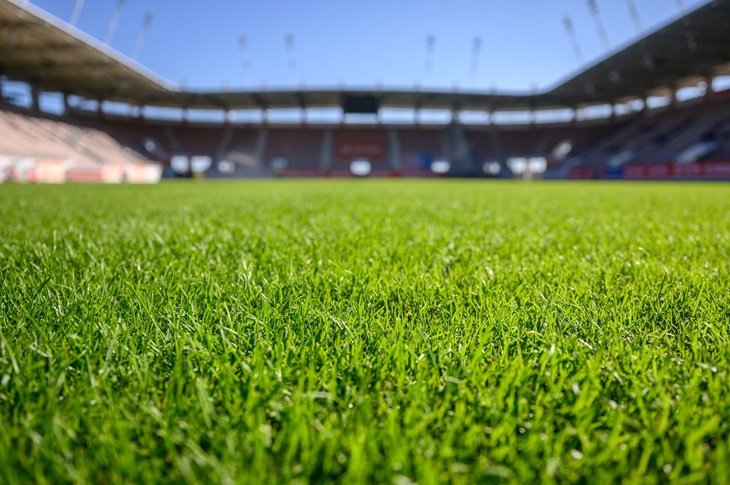
Getting a football pitch ready ahead of a new season or ahead of a match involves several steps to ensure that the playing surface is in great condition for both player safety and performance.
From mowing the grass to tips on football pitch markings, this guide looks at what needs to be considered when preparing a pitch for a new season or an upcoming match.
Cutting the grass
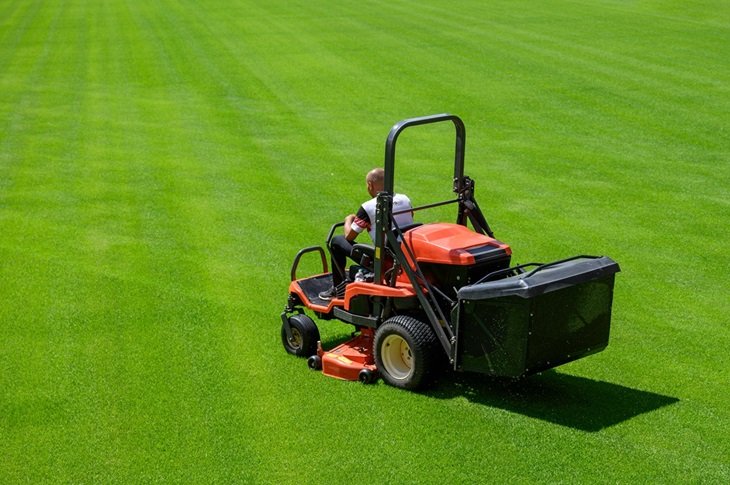
One of the most important aspects of the football pitch preparation process is to cut the grass. It needs to be mowed regularly, ideally, two or three times a week when the weather allows.
The grass height on professional pitches should be around 25-30mm, but the grass height on many local authority pitches is between 25 and 50mm.
Many groundsmen or women, especially at the professional level, will cut patterns on the grass. While some football fans might think that this is purely done for the aesthetic appeal, it does prevent the grass from leaning in one direction, which can stop ruts being formed on the playing surface. Varying the mowing pattern also helps prevent the grass being worn out by the wheel tracks from the mower.
ALSO READ: Thank you gifts for football coaches
Aeration
Aerating a pitch is a vital part of the preparation process as this helps compaction, drainage, and benefits the growth of the grass.
This process must take place whenever soil conditions are suitable, and a regular aeration programme needs to be carried out.
Groundsmen and women or coaches will normally use solid tine or hollow tine aeration depending on the soil compaction and time of year. Solid tine aeration is where solid spikes are driven into the ground to create holes without removing soil, whilst a hollow tine aerator drives hollow spikes into the surface of the pitch and removes cores of soil.
If soil conditions are too wet, then aeration will reduce the drainage potential of the football pitch through both smearing from the tines and compaction from the operating unit.
The process of aerating a pitch needs to be done several times a year, but it is best to do this when the weather is mild. If you are conducting regular slit tine aeration in unsuitable ground conditions, this can have a detrimental effect on the playing surface.
Rolling the pitch
Rolling the pitch should not be carried out during the winter months when the pitches are wet, as this can damage the playing surface.
It is often recommended that you roll pitches at the very beginning and end of the season when the playing surface is firm, and the grass has grown on it.
The Grounds Management Association adds: “On high sand specification pitches, where stability and erosion can be a problem, especially as vegetation content starts to be reduced, then a light rolling of the surface, under suitable root zone moisture conditions, can help to maintain root zone and grass root cohesion for a bit longer.”
ALSO READ: What are the best penalty kick training drills?
Pitch presentation and using divot mixes
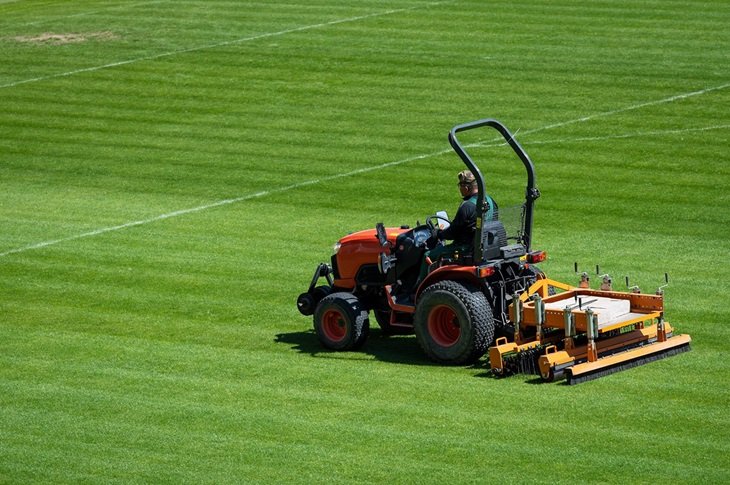
After aerating the pitch, one of the next jobs that you need to consider is the presentation of the surface. Many grounds people will apply a mixture of sand, soil and compost to help level out the surface or the structure of the soil, as this can enhance grass recovery.
Leaves can often be a problem on grassroot pitches, which are located near trees, as leaves can affect the grass and the playing surface. Clearing any leaves on the pitch will therefore need to be a regular job.
An essential job that should be a part of the process of preparing a football pitch is fixing divots. After every game that is played, there will be lots of divots which need fixing, and these should be trodden back down and replaced by hand once the game has finished.
Depending on how many divots there are, this can take a day or multiple days to fix. At the professional level, this job will be conducted straight after games and there will be multiple ground staff on hand to fix them, but at the grassroots level, even if you spend an hour or two fixing divots it can really help the playing surface of the pitch.
Fertilising
The main constraints around fertilising a pitch at the grassroots level can be budget and time. At the elite level, fertiliser will often be applied, but at the grassroots level, it will depend on time and a club's budget.
Slow-release fertilisers are an excellent product for applying larger amounts of fertiliser in an economical and environmentally sustainable way.
Germinal, a grass seed supplier, talks about fertilising a football pitch: “If the budget only allows for one fertilisation, a slow-release product such as GSR Tri-Phase (18-3.5-8 plus TE) should be applied at the time of renovation around April/May time. This will encourage growth and recovery to existing grass coverage, act as a pre-seed fertiliser for any overseeding works and encourage growth through the close season until teams return.”
It is best to use a spreader to ensure that the fertiliser you are spreading over the football pitch is done evenly.
Irrigation
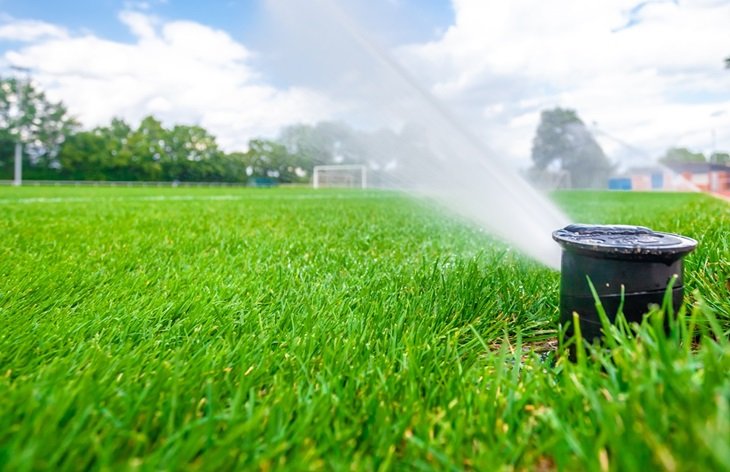
Professional clubs will normally water their pitches throughout the season. Pitches with a high sand content, especially those with undersoil heating, need regular irrigation to prevent the root zone from drying out too much.
At the grassroots level, it is vital that the pitch is watered regularly during dry periods, especially during the summer, even though the season has finished by this stage. The amount of water needs to be sufficient enough to moisten the soil, and it is best to water the pitch either early in the morning or late in the evening to prevent evaporation losses.
At the grassroots level, you will not need to water the pitch all year round, especially if you have had a period of wet weather, as this could waterlog the pitch.
ALSO READ: Football workouts to improve your fitness and your game
Weeding the pitch
It isn’t just gardens that need weeding; football pitches also need to be weeded. It is best to carry out this task using a herbicide after the season has finished, but if this has not been effective, you should spray the pitch again in September.
Some pitches, which are in a lot of shade throughout the autumn and winter months, might experience algae growing on them, but this can be removed by scarification, which is the process of using a tool to clear matted grass and moss from the surface of the pitch, or similar types of operations.
If you are using herbicides, pesticides, and fungicides, you will need to ensure they are suitable for sports pitches and are applied according to the manufacturer's guidelines.
Marking out the pitch
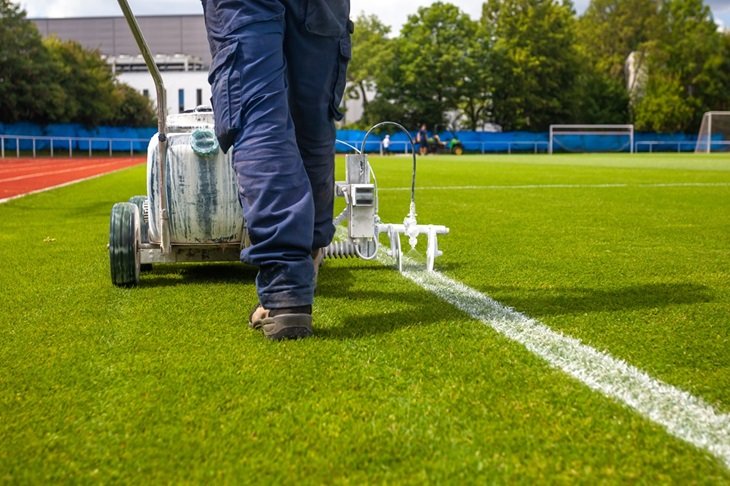
From measuring the size of your football pitch to marking out the lines, this is one of the most important jobs when it comes to preparing the pitch.
Prior to each match, the pitch needs to be marked so it complies with the laws of the game. The grounds people, managers, coaches or even players, in some cases, will need to overmark the pitch, especially parts of the lines that are worn.
Typically, the goalmouth, penalty area, corners and centre circles are the areas of the pitch that will need the most care and consideration, but quite often, the whole pitch, including the sidelines, will be overmarked.
Usually, the whole pitch is overmarked once a week, but heavy rains could wash away the marking, so the pitch will need to be marked more regularly.
You will need to use a line marking machine and apply the marking paint, and you need to ensure the lines are straight and visible to the players, officials, and supporters. You need to follow the FA's instructions for the dimensions and markings.
ALSO READ: When is the grassroots football season in the UK?
The equipment and final safety checks
Before any games are played on the pitch, the final checks you need to make are around the goal nets, as well as safety.
You need to check that the goals are securely in the ground. Ensure that the nets are properly attached to the goal posts and crossbar, and that they are pegged into the ground.
You should also double-check that the nets are not damaged and there are no holes in them, as this will be checked prior to kick-off by the match officials.
In regard to safety checks, either the ground staff, managers, or coaches should walk around the pitch to ensure that there are not any holes, uneven surfaces or debris.
ALSO READ: What should be in a football first aid kit?
Football pitch preparation checklist
Properly maintaining a football pitch requires consistent care and attention, and here, we round up the jobs that will need to be carried out to prepare a pitch.
- Cutting the grass
- Aeration
- Rolling the pitch
- Pitch presentation and using divot mixes
- Fertilising
- Irrigation
- Weeding the pitch
- Marking out the pitch
- The equipment and final safety checks
If you are associated with a football club, you will need to ensure that you have the correct football equipment. From football balls to football water bottles, you can buy everything you need for a training session or a match day from Diamond Football.
For more tips, guides, and advice, visit our news page.




